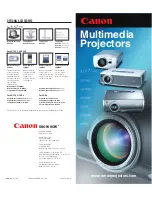
4 of 10
Convergence Instruction Sheet
020-100703-01 Rev. 1 (05-2011)
BEFORE PERFORMING CONVERGENCE
• Make sure the image-zoom and centering is complete before performing convergence.
For details, refer to
3.2 Integrator Alignment, on page 3-2
,
of the CP4220 and CP4230 Service
manuals (P/N: 020-100691-xx/020-100622-xx)
.
• Make sure boresight procedures have been completed before performing convergence.
For details, refer to
the
CP4220 and 4230 User Manual (P/N: 020-100690-xx/020-100621-xx)
.
• Use only a prime lens when performing convergence. DO NOT use an anamorphic or Wide Con-
verter Lens (WCL).
• The projector should be set up to final maximum usable brightness for the installed application.
• 14FL for Standard 2D
• ~25-30FL for Single Projector 3D with a silver screen
• 25FL per projector for Dual Projector 3D
• Once at the required power setting, the unit should be allowed to come “up to temperature” for at
least 15 minutes. Note this nominal operating temperature for monitoring as you perform conver-
gence.
IMPORTANT:
During convergence, the lid and/or filter side of the projector will be open, causing
decreased prism cooling performance and possible shifts in convergence or DMD focus. The prism
temperature should be monitored during the adjustment and kept within a few degrees of the nominal
temperature achieved above by lowering the lamp power or periodically replacing the cover for a
cool-down.
• Watch for over-temperature alerts when running near 6000W. Cool-down periods with the shutter
closed and cover on may be required.
• The active screen file should be
4096 x 2160 no crop
to prevent any scaling of your reference test
pattern.
• Typically the blue image component can be used as the fixed reference, so no adjustment is required.
However, if you need to adjust the blue image component it is easy to adjust, but the side panel must
be removed. The recommended normal convergence adjustments are from green to blue and red to
green.
• It is recommended that the vertical and rotation adjustment be done first, as they work dependently
together and the horizontal adjustment done last.
• Use extreme caution to not damage any components on the board.
• DO NOT push or force the adjustment screws when turning them.
• You do not always have to turn the screws simultaneously; however, adjusting one at a time will
cause the need for an equal or equal and opposite turn on the other to achieve the adjustment desired.
• There are no Lockdown screws with the CP4220 and CP4230 light engines.




























